|
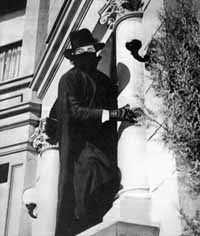
Victor Jory fighting crime
in The Shadow.
This apparent mood of reassurance is a radical break with the entire purpose of the cliffhanger—to keep us in suspense until next week’s resolution. In Chapter Ten, "The Underground Trap," there is no suspense. The Shadow busts in on the Black Tiger’s men who want to invade a bank vault from an underground cave. An acetylene tank explodes (surprise?) and the Shadow is buried under a rubble of rocks and beams (what else?). The narrative flashforward (an odd feature in Columbia serials that tells us what’s in store next week) shows the Shadow rising from the wreckage! The kids in the theater don’t even have to wait a week to know that all’s well. By contrast to Columbia’s safe security, Republic serials are exciting and vivid because of their chapter endings (the quality of the stunt and the questions and speculations raised in the audience before the accompanying week’s resolution), and how well Witney and John English play with film form (expanding time through additional edits or closing off a previous week’s absent reverse shot).
But there is innovation at work in The Shadow. In Horne’s shift away from the audacity of the cliffhanger to more subtler forms of filmic mood and cultural critique, The Shadow becomes a pleasingly strange brew of proto-noir verve and down-home hokiness.
The proto-noir elements bleed through the opening credits. A parabolic light umbrellas crooked letters that spell "The Shadow." Darkness fills the empty spaces and Jory menacingly intones, "I am the Shadow." Menace also embeds Jory’s costume. The dark cape billows as he runs down a path or drops from a skylight, and the black mask and crouched hat combine gangster mythology with the western outlaw to create a double-image of fear. This image resonates strongly through Jory’s presence—hawk eyes, hooded over the mask, penetrating all around him.
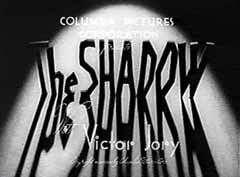
The opening titles from The Shadow.
Hear Victor Jory intone "I am the Shadow."
(WAV, 7 seconds, 80 KB)
James S. Brown’s cinematography also captures the proto-noir cityscape. Shot in day-for-night, Brown’s images of polished cars knifing through angular urban shadows, and the Shadow wandering through various black-splotched warehouses are surprisingly crisp and much darker than Republic's serials or Columbia’s later efforts produced by Sam "Quickie" Katzman. But Brown’s best visuals are saved for creating an aura of hard menace around the Black Tiger. In almost every episode, the Black Tiger slinks down a black hallway and stands, his back to the camera, as bright conical light filters through chalky dust to make him invisible.
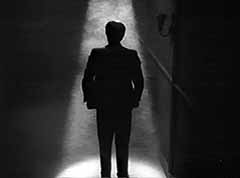
The Black Tiger from The Shadow.
Nobody knows the identity of the Black Tiger. When he meets his men, the aura of menace and dangerous technology continues. The invisible Black Tiger sits in a slightly swinging, gilt-edged chair, and hardness emanates from his voice as two coiled transmitters intermittently flash and smoke spews from the mouth of a tiger head centering the desk. He gives his orders of destruction in a drawn-out gutter drawl, and even on occasion destroys, in front of everyone, a gangster who failed him.
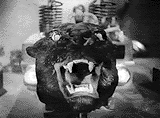
The tiger head from The Shadow.
No doubt compelling bad guys have always made for interesting storytelling, but Horne (who previously directed Laurel and Hardy) draws criticism from serial fans for his down-home hokiness. Critics see his "comedy" as a sign of disdain for the form he’s working in. And sure hokiness abounds in Horne. In one episode, gangsters chase the Shadow out of a building. He hides behind a seven-foot hedge, and none of them stop to look there as they run past. The Shadow, now criminologist Lamont Cranston, reemerges from the hedge, smiling at the joke. In another "hedge" joke, a gangster jumps the Shadow, and they tumble out of the frame. When the Shadow reemerges from the hedge, three other gangsters jump and thump him. They take off the crouched hat and discover it’s their own guy. The Shadow, while in the hedge, pulled the old switcheroo!
Maybe this isn’t your idea of what a serial should be, but Horne’s comedy creates a self-reflexive posture that makes us question what we value in serials, and ultimately opens the text up to larger ideological questions. One such question concerns the perception white Americans have of Asian Americans. Throughout the serial, Jory dons a black wig, some make-up, and eye-enhancers to become Lin Chang, "oriental" gangster. Jory’s Chang—the stereotypical accent, the fawning obsequiousness—is played for racist laughs, but Horne has the last laugh on us all. In Chapter Eleven, "Chinatown Night," the Shadow, riding with his assistant Vincent (a cabbie), is hotly pursued by the police (they suspect the Shadow of being a criminal). Vincent stops in front of the Oriental Bazaar and out of his cab steps Lin Chang. "Oh, you want something from me," he says in an exaggerated voice to the befuddled cops who lazily scratch their heads. "Oh, I could have sworn this was the cab," says one with a dazed voice. "Okay, buddy, get moving," says the other. This moment of denying the presence of a true absence of Asian identity is ludicrous. Clearly, the vehicle’s license plate and cab number remained consistent throughout the chase, clearly the Shadow is Chang, but never for a moment do the police suspect that Chang is a white guy masquerading as an Asian. Horne’s joke may be saying that "all Asians look alike," but he’s also making a subversive comment: whites don’t really look at minorities; instead, whites accept cultural stereotypes as real. And for that insight, I like James W. Horne.
The Serials: An Introduction
Page 1: In the Theaters
Page 2: The Beginnings
Page 3: Enter Flash Gordon
Page 4: The Golden Age
Page 5: The Downfall
The Phantom Empire
Flash Gordon
Dick Tracy
The Fighting Devil Dogs
Zorro's Fighting Legion
The Shadow
Mysterious Dr. Satan
Spy Smasher
Perils of Nyoka
The Tiger Woman
Serials Web Links
|


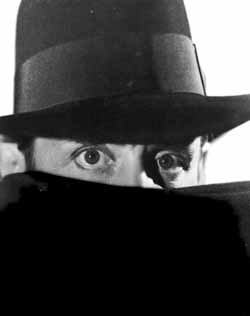 James W. Horne’s The Shadow (1940) contains some of the lamest cliffhangers in serial history.
James W. Horne’s The Shadow (1940) contains some of the lamest cliffhangers in serial history.




